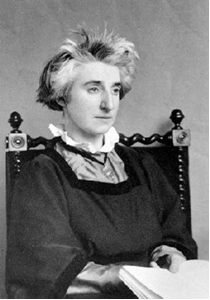- 1610: Galileo
- 1676: Ole Rømer
- 1687: Isaac Newton
- 1781: William Herschel
- 1838: Friedrich Bessel
- 1861: William and Margaret Huggins
- 1912: Henrietta Leavitt
- 1917 Einstein
- 1920: Harlow Shapley
- 1929 Edwin Hubble
- 1948: Ralph Alpher
- 1949: Fred Hoyle
- 1963: Maarten Schmidt
- 1964: Arno Penzias and Robert Wilson
- 1978: Vera Rubin and Kent Ford
- 1989: Margaret Geller and John Huchra
- 1992: John Mather and George Smoot
- 1995: Robert Williams
- 1998: Saul Perlmutter and Brian Schmidt
- 2010: Wendy Freedman
1861: William and Margaret Huggins Show Stars are Suns
 |
| Margaret Huggins. Image courtesy of Wellesley Observatory. |
Once Bessel and others were able to measure the distance to a star early in the 19th century it was possible to determine its brightness compared with the Sun. As many astronomers suspected, stars were not the tiny dots of light that ancient peoples thought them to be, but were almost certainly distant suns whose light was reduced only because they were at such a vast distance. But it was still not possible to compare the composition of the stars with the composition of the Sun, and consequently show for certain that they were indeed made of the same stuff. The task of making that final connection, and laying the foundation for modern spectroscopy was accomplished by William and Margaret Huggins, who worked in their own private observatory at 90 Upper Tulse Hill, South London.
Oddly enough it was a chemist, Robert Bunsen, who made the first breakthrough by inventing a device that made it possible to analyze the color of light from a hot glowing gas, and use that information to determine the elements that produced the light. Initially he used the device, a spectroscope, to discover new elements in the laboratory (cesium and rubidium). Later he was joined by astronomer Gustav Kirchoff to observe the Sun, finding it to be composed mostly of hydrogen gas.
 William Huggins, shown here next to his telescope, is given credit for being the first to detect the same elements in stars as Bunsen and Kirchoff found in the sun—demonstrating very clearly that the stars are indeed Suns, and the Sun is a star. He did that by combining the power of the telescope to capture the light of a star with the capability of a spectroscope (the odd contraption next to Huggins attached to the end of the telescope) to split the starlight into its constituent colors. Today Margaret Huggins is given credit as a co-investigator.
William Huggins, shown here next to his telescope, is given credit for being the first to detect the same elements in stars as Bunsen and Kirchoff found in the sun—demonstrating very clearly that the stars are indeed Suns, and the Sun is a star. He did that by combining the power of the telescope to capture the light of a star with the capability of a spectroscope (the odd contraption next to Huggins attached to the end of the telescope) to split the starlight into its constituent colors. Today Margaret Huggins is given credit as a co-investigator.
As Newton showed that the same laws of motion applied in the heavens as on Earth, Margaret and William Huggins demonstrated that the same elements made up all of the known cosmos.
William and Margaret Huggins continued their spectroscopic work on stars for many more years, and in 1868 announced yet another important discovery that would have profound implications for cosmology. When observing Sirius, the brightest star in the sky, they found that the spectral lines were shifted slightly towards the red side of the spectrum. This shift in the spectral lines implied that Sirius was traveling away from Earth at about 135 miles per second. They measured other stars as well and found that a few exhibited a shift in spectral lines towards the blue side of the spectrum, indicating they were traveling towards Earth. This method, called the Doppler shift, would eventually be used to learn the true nature of faint clouds called “nebulae,” and would eventually lead to the discovery of the expanding universe in the 20th century.